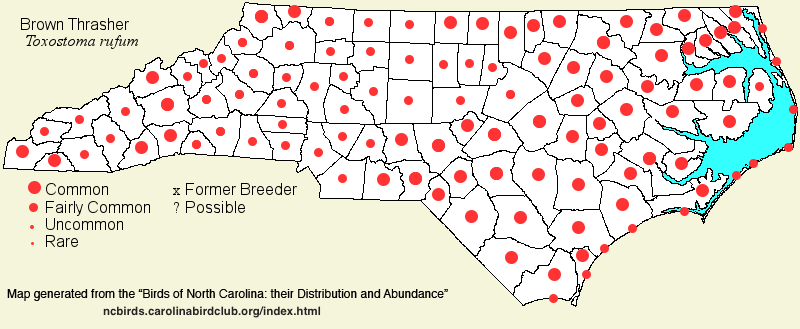 |  |
|
Brown Thrasher - Toxostoma rufum MIMIDAE Members: | Search Common: Search Scientific: |
|
|
|||||||
| General Comments | The Brown Thrasher is the largest of the three breeding mimic-thrushes in the state, and its range in the state is somewhat intermediate between that of the Northern Mockingbird and Gray Catbird. The former occurs across the state in winter, whereas the Gray Catbird is found in winter essentially in the Coastal Plain. As with the other two, Brown Thrashers nest in all 100 counties, but it winters mainly in the Coastal Plain and Piedmont, though small numbers do occur in the lower mountains in winter. As with the other two, thrashers breed in residential areas and farmyards, favoring hedgerows and other dense cover; however, this species breeds in most extensive clearcuts and other overgrown fields with saplings and shrubs. In winter, they occur in the same types of habitats as in the breeding season, but they become quite secretive, skulking about inside and under dense and usually evergreen shrub and thicket cover, even inside some forests. | ||||||
| Breeding Status | Breeder | ||||||
| NC BRC List | Definitive | ||||||
| State Status | |||||||
| U.S. Status | |||||||
| State Rank | S5B,S5N | ||||||
| Global Rank | G5 | ||||||
| Coastal Plain | Permanent resident, with some migratory movements. Except in winter, common across most of the region, though only fairly common on barrier islands such as Hatteras and Ocracoke. In winter, fairly common over most of the province, being slightly more numerous near the coast. Peak counts: | ||||||
| Piedmont | Permanent resident, with migratory movements. Except in winter, generally common across the eastern and central portions, but fairly common in the foothills. In winter, fairly common along the eastern and southern portions, but uncommon (in midwinter) in the remainder of the region; can be scarce in some areas after severe weather events. Peak counts: | ||||||
| Mountains | Permanent resident, though scarce in winter. Fairly common to common in summer in the lower and middle elevations, up to about 4,000 feet; sparingly higher. In winter, rare to uncommon by midwinter in the lower elevations, and quite rare above about 2,500 feet. Peak counts: | ||||||
| Finding Tips |
None needed (in summer). **** | ||||||
| Attribution | LeGrand[2023-03-27], LeGrand[2012-09-27], LeGrand[2011-12-12] | ||||||
| NC Map Map depicts all counties with a report (transient or resident) for the species. | Click on county for list of all known species. |
| NC Breeding Season Map Map depicts assumed breeding season abundance for the species. |  |